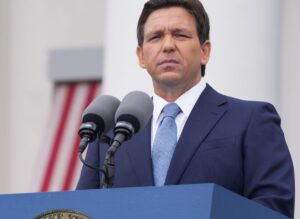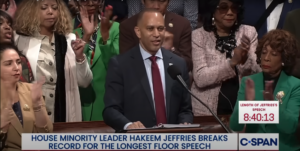In November, voters will choose between two radically different visions of education in America. One favors the public education system and supports the teacher unions’ view that more resources are what is needed to fix our broken system. The other proposes decentralizing education decisions, weakening federal mandates and powerful unions, to empower parents as the best advocates for what are the most appropriate methods to educate their children.
The increasing likelihood of a Donald Trump versus Joe Biden rematch means that, instead of comparing various rosy campaign promises and platitudes, voters will be able to judge the candidates based on the actions of their respective administrations. There is an objective record we can look at, aside from partisan, political affinities. While President Trump oversaw an administration focused on broadening education options, President Biden is committed to more resources allocated to the current public school system.
During the Biden Administration, the nation has been confronted with historically concerning civics and U.S. history scores. In the most recent report card from the National Assessment of Educational Progress (NAEP), only 22% of eight-graders were proficient in civics. Just 13% were proficient in history. Worst of all is that only 31% of those students were reading at an adequate level. Two years of shuttered schools during the COVID-19 pandemic contributed to those results, but they are also evidence of years of decline in the American education system.
The Biden Administration believes the remedy to this is increased funding for public education. One way to do that is to cut the budget elsewhere, such as restricting funding for charter schools by drafting new regulations. Charter schools are still publicly funded, but they operate independently from the many of the rules that govern and sometimes constrict regular public schools. They often offer low-income communities the opportunity to attend a higher-quality school even if they can’t afford other private education alternatives. The regulations proposed by the Biden administration make it more difficult for new charter schools to open and provide those families with more education options.
The Administration has also spoken out against other non-public school programs. In a speech criticizing Democrat Pennsylvania Gov. Josh Shapiro’s voucher program, U.S. Education Secretary Miguel Cardona stated that he is “totally against any public education dollars going to private school vouchers.”
In lieu of funding private alternatives, President Biden signed the American Rescue Plan into law, the single largest investment in public education ever. The bill set aside $170 billion specifically for public schools, not private schools, known as the School Rescue Funds. In order to access those funds, states must include teachers’ unions as stakeholders who have a say in how those funds are spent. But these unions have faced heavy criticism for not putting the interest of children first. Their forceful push to keep schools closed during the pandemic was just the latest example of a long history of concerns by many Americans.
Another key characteristic of the Biden Administration’s education policy is that professionally trained educators should be trusted over parents when it comes to educating children. That stipulation in the American Rescue Plan that teachers’ unions be included in the decision-making process highlights this belief.
This is a philosophy that Administration officials have often stated. During a Senate hearing in 2021, Secretary Cardona declined to say that parents should be the “primary stakeholders” in their children’s education, instead saying that educators play a vital role. He has repeated this sentiment numerous times, including in a Twitter post where he stated that “teachers know what is best for their kids because they are with them every day. We must trust teachers.”
Though it was never passed by Congress, the Biden Administration wanted to implement the American Families Plan as a follow-up to the American Rescue Plan. The American Families Plan would have been a large extension of public education in America. It would have added four more years of free education by providing for public pre-K as well as two years of community college. This too highlights the philosophy that the more time children spend with certified educators, the better off they will be.
The Biden Administration’s policies are a stark contrast to the four years preceding his tenure in which the Trump Administration championed the most robust school choice agenda in decades.
In a Rose Garden speech in 2020, Trump stated that “we’re fighting for school choice, which really is the civil rights of all time in this country …. Frankly, school choice is the civil rights statement of the year, of the decade, and probably beyond, because all children have to have access to quality education.” The Trump Administration went on to follow the President’s rhetorical lead and implemented policies that emphasized school choice and parental involvement.
In April 2017, President Trump signed his first executive order, a directive to protect and preserve the role of states in education. The order initiated a review of all federal regulations that undermined state and local control of education. It emphasized a belief that education policies are best handled by individual localities, rather than officials in Washington.
Trump’s pick to oversee this agenda, Secretary of Education Betsy DeVos, had no prior public-school experience and was a champion of charter schools in her home state of Michigan. Her nomination was evidence of the Trump Administration’s view that the education system was in desperate need of fixing and that the right person for the job was an outsider willing to buck the status quo.
DeVos summed up her ideology in a 2019 speech by saying that “government has never made anything better or cheaper, more effective or more efficient. And nowhere is that more true than in education.” During her tenure, DeVos argued for massive cuts in the Department of Education’s budget. That same budget proposal included increased funding for charter schools and private school vouchers. She also championed a bill introduced by Sen. Ted Cruz (R-Texas) that would have used the federal tax code to bolster nonprofit school scholarships.
While those efforts were ultimately stymied by Congress, several other initiatives were successful. Under Trump’s 2017 Tax Cuts and Jobs Act, 529 savings accounts were expanded to allow for K-12 expenditures, including private school tuition. Previously, these could only be used for higher education expenses.
Unlike the Biden Administration’s American Rescue Plan, the Trump Administration included private schools in their COVID relief measures. One of the COVID relief packages passed by Congress, the Coronavirus Aid, Relief, and Economic Security (CARES) Act, included $30.75 billion for education, much of which was allocated to non-public schools. Devos’s DOE also issued guidance that directed local public-school districts to share pandemic-related federal funds with nearby private schools. It is notable that, while many public schools remained closed during that time, many students in private schools continued receiving in-person learning.
The American people have a choice to make in 2024 when it comes to education. One vision believes that public education is simply underfunded and that educators rather than parents should be empowered to direct the education of kids. The other favors innovation to give families more alternatives in addition to the public school system.
One thing is clear, the choice Americans make in November 2024 will have a significant impact on our children’s future.





